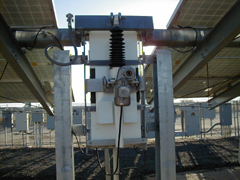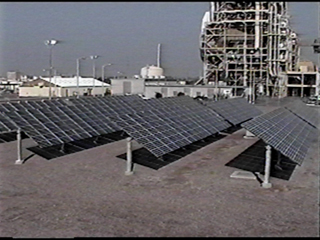SolarTrak®
Development Milestones
Beginning in the late 1980's, Alex Maish, at Sandia National Laboratories,
began development of the SolarTrak technology. Responding to industry needs
for low-power, dependable tracking control for a variety of mechanical systems,
several iterations of imbedded microcontroller boards and a wealth of computer
code produced the initial successes that have subsequently become the basis
for the most compact, high-precision sun-tracking controller on the world
market.
The first commercial licenses, issued by SNL, were placed in the early 1990's
using the code developed by Mr. Maish. The first commercial version to come
on the market was produced by the Utility Power Group out of San Luis Obispo,
California, as an add-on circuit to their proprietary inverter design.
Configured as a single, horizontal-axis oriented north-south, each row is
comprised of two seven kilowatt sections of photovoltaic flat-plate panels
rotated east

to west by a 5-ton linear actuator mounted at the center of the 150-foot torque
tube and driven by a half-horsepower NORD 3-phase AC motor.
In
order to prevent the closely-grouped rows from shading each other at low sun
angles, an event which can diminish power output and even cause permanent damage
to the solar cells, Mr. Maish continued his development, assisting his commercial
licensees by implementing a tracking strategy ultimately known as 'Backtracking'.
When the sun angle is so low that the adjacent rows would normally begin shading
each other, either in the early morning or late afternoon, rather than continuing
to track the sun, the panels are driven away from the sun to a flatter position
sufficient to avoid shading.
Page
1 - The Early Days
While
the Sun is high enough in the sky, the multiple-row array fields can be aligned
with the sun angle, maximizing the electrical power generated by the photovoltaic
(PV) panels. This is certainly the optimal mode of operation. During the summer
when peak demand occurs at roughly 3 PM, this arrangement offers nearly direct-normal
(perpendicular) alignment with the Sun where it produces its maximum potential
output.
Early
in the morning or late in the afternoon when the sun angle dips below a critical
angle where the adjacent rows can shade each other, a decision must be made
that involves a trade-off between making power or potentially doing damage to
the PV panels. If a string of cells in series with other cells is shaded, that
string will stop conducting and prevent the current flow through a panel. At
high enough power and voltage levels this can cause permanent damage to the
cell junctions or to the cells themselves.
Since
the SolarTrak® controller is a computer-based device rather than just a
sun-sensor that tries to follow the sun by 'seeing' the hot spot in the sky,
it has the option of doing something other than just follow the Sun. By computing
the required angle that will just barely remove the shadows from the adjacent
row, based on the width of the panels and the spacing of the rows, the controller
can properly position the panels to allow uniform illumination of the whole
panel while just barely avoiding the shading effects. The effect of this
control
strategy makes the panels move backwards with respect to the actual relative
sun motion, hence the term 'Back Tracking'. Admittedly, this tracking strategy
reduces the power output due to the decreasing relative angle but the alternative
is killing the power output altogether due to lack of current flow or damaging
the panels.







